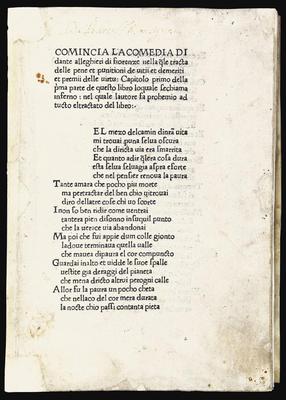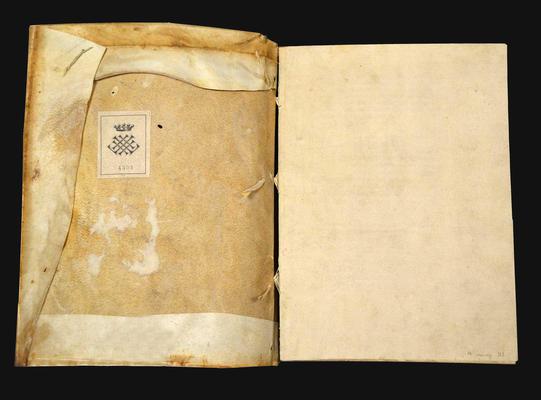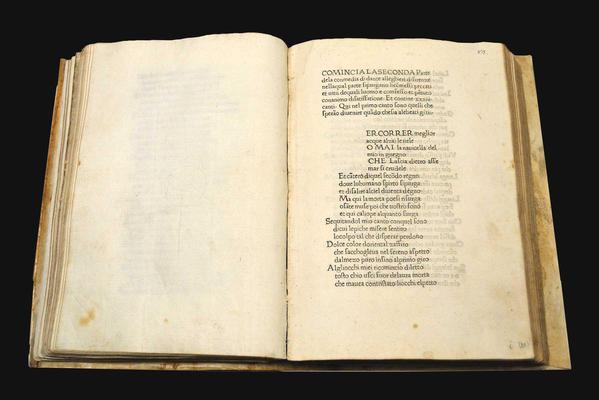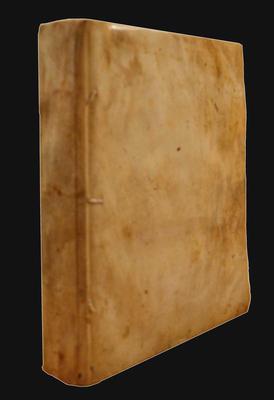Dante Alighieri
Comincia la Comedia di dante alleghieri di fiorenze...
Foligno, Johann Neumeister and Evangelista Angelini, 11 April 1472.Folio (282x200 mm). Collation [a-b10, c12, d-f10, g12, h10, i-m10, n12, o10, p12, q10, r10, s12, t-u10, x12, y-z10, &10]. [248] of [252] leaves, lacking the blanks [a]1 and [&]10, and the text leaves [a]10 and [&]9, supplied in facsimile on old paper. Text in one column, 30 lines. Type: 1:124R. Inked foliation in a seventeenth-century hand in the upper margin. Later binding in antique vellum. A fine wide-margined copy. Old repairs to the inner margin of the first leaf of text; a few pale finger-marks. Numerous marginal notes in a contemporary hand, referring to leaves misbound in this copy; some annotations in a seventeenth-century hand.
Provenance: a seventeenth-century ownership inscription on fol. a2r, barely legible (‘Barth' ?); Baron Horace de Landau (1824-1903; ex-libris on the front pastedown; Catalogue des livres manuscrits et imprimés composantla bibliothèque de M. Horace de Landau. Première partie, Florence 1885, p. 154, “2 ff. refaits”); Livio Ambrogio collection.
A fine wide-margined copy of the Foligno Dante, one of the three editions of the Commedia printed in 1472 (besides this one, there were also Mantuan and Venetian editions). The edition is commonly regarded as the first Commedia in print; in effect the volume printed by Johann Neumeister and Evangelista Angelini is the first to have a precise date in the colophon: the colophon of the Mantuan publication has only the year, and the Venetian one was printed later than Foligno, on 18 July.
This masterpiece of early typography, of great historical and philological importance, was produced in the thriving commercial ambience of late fifteenth-century Foligno (in Umbria) by Johann Neumeister, a former employee of Gutenberg. He had arrivedfrom Germany in 1463-1464 to work as a scribe and in around 1470 had established the first printing press in the city, in partnership with Evangelista Angelini from Trevi. The neat types employed – an antiqua similar to the font used for the Subiaco Lactantius printed in 1465 by Conradus Sweynheym and Arnoldus Pannartz – were designed and cut by the goldsmith and official in the Papal Mint Emiliano di Piermatteo degli Orfini. After printing only three books – De bello Italico adversus Gothos gesto by Leonardo Bruni (1470), the Epistolae ad familiares by Cicero (about 1471) and the Dante – the partnership dissolved, and Neumeister returned to Mainz. No other edition was published in Foligno during the rest of the fifteenth century and the early decades of the following. The text of the Commedia is given here without commentary. It was prepared by Neumeister's partner Angelini, on the basis of a manuscript belonging to the renowned Florentine series known as the Dante del Cento, identified asmsLolliniano 35 of the Biblioteca del Seminario in Belluno, which has identical vernacular rubrics prefacing each canto, and the same lacunae in the third cantica (Paradiso,xx49-54 andxxi 46-48). The copy presents, among others, the variant ‘puro et dispostto a salire alle stelle |soli deo gloria' in the final verse of the Purgatorio. The variants are also pointed out in the catalogue, published in 1885, of the outstanding library of the great bibliophile Horace de Landau, to whom this handsome copy then belonged: “Probablement on corrigea le texte dans le cours du tirage, car il y a des variantes entre l'un et l'autre exempl. Le premier vers du 8ef. p.e. contient dans le nôtre la forme mercede, tandis que dans d'autres il y a mercedi”.






